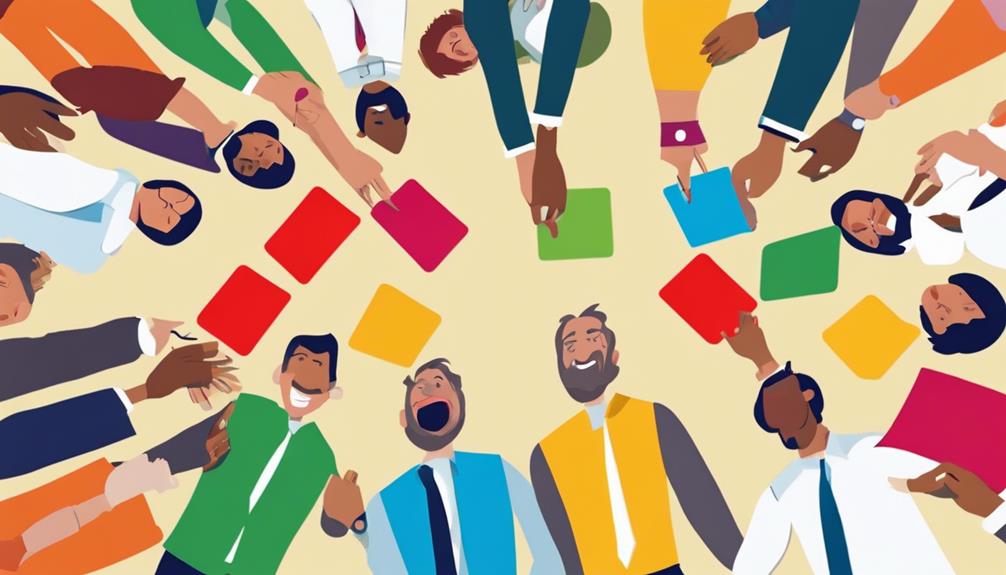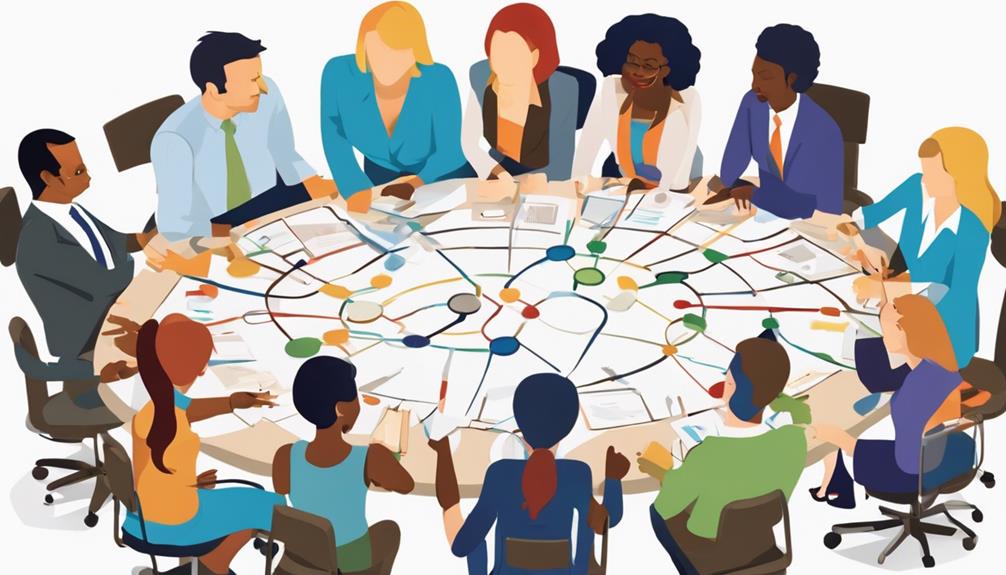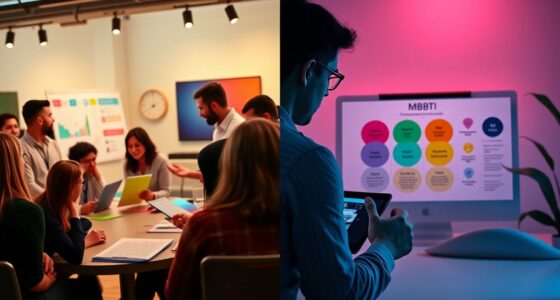As we navigate the complex dynamics of teamwork, it becomes crucial to explore how individuality and collective strength are interconnected.
Imagine a tapestry where every thread represents a unique DiSC style interwoven with others to create a masterpiece of collaboration.
In our quest for synergy and success, these engaging DISC Assessment Activities offer a gateway to unravel the mysteries of team dynamics and unlock the full potential of our collective efforts.
Through tailored exercises and interactive experiences, teams can uncover hidden strengths, bridge communication gaps, and forge a path towards cohesive teamwork.
Let's embark on this journey together and discover the transformative power of DiSC assessment activities in shaping high-performing teams.
Key Takeaways
- DiSC assessment activities enhance team building through understanding styles and improving communication.
- Conflict resolution techniques help manage conflicts effectively within teams.
- Collaborative activities promote teamwork, trust building, and mutual understanding.
- Maximizing Everything DiSC training impact boosts engagement and overall team effectiveness.
Understanding DiSC Styles Activities
In exploring Understanding DiSC Styles Activities, we engage participants in interactive exercises that bring to life the intricacies of DiSC styles through practical applications. Team Building is at the core of these activities, designed to enhance collaboration and communication within groups. The DiSC Profile serves as the foundation, providing insights into individual behavioral tendencies and preferences.
One key activity is DiSC Role Play, where participants apply DiSC styles in various workplace scenarios to understand how different styles interact and affect team dynamics. Personal DiSC Badge creation is another engaging exercise that visually represents each individual's DiSC style, fostering self-awareness and mutual understanding among team members. Storytelling Sessions offer a platform for sharing personal experiences through the lens of DiSC styles, promoting empathy and appreciation for diverse perspectives.
Guess the Style game is a fun and interactive way to link actions to DiSC styles, encouraging participants to identify and understand behavioral cues. Lastly, the DiSC Style Sculpture activity allows for creative representation of DiSC styles using crafting materials, sparking creativity and enhancing teamwork.
Enhanced Communication Activities

Exploring the realm of Enhanced Communication Activities within the context of DiSC assessment facilitates a deeper understanding of effective communication strategies tailored to individual styles and preferences. When engaging team members in DiSC communication activities, we can enhance their skills through various interactive exercises:
- DiSC Communication Swap: Encourages participants to navigate different communication scenarios based on their DiSC styles.
- Feedback Carousel: Designed to practice and provide effective feedback within the framework of DiSC communication styles.
- Email Decoding Exercise: Involves decoding emails written in specific DiSC styles to grasp various communication preferences.
- Silent Meetings: Promotes non-verbal communication skills by conducting meetings using only non-verbal cues aligned with DiSC styles.
Conflict Resolution Activities
Engaging in Conflict Resolution Activities through DiSC assessment fosters effective communication and collaboration within teams by addressing and resolving conflicts based on individual styles and preferences. One effective method is the DiSC Conflict Role Play, where team members act out conflict scenarios reflecting different DiSC styles. This hands-on approach allows participants to understand how each style responds to conflict. Another valuable activity is Style Mediation, pairing individuals with contrasting DiSC styles to practice resolving conflicts constructively. The Hot Seat activity enables team members to tackle workplace challenges from various DiSC perspectives, promoting a deeper understanding of each other's preferences. Conflict Mapping is also beneficial as it helps teams analyze past conflicts, identify recurring patterns, and pinpoint areas for improvement. Lastly, the Style Swap activity encourages team members to view disagreements through different DiSC style lenses, fostering empathy and enhancing conflict resolution skills.
| Conflict Resolution Activities | Description | Benefits |
|---|---|---|
| DiSC Conflict Role Play | Team members act out conflict scenarios based on different DiSC styles | Understanding how each style responds to conflict |
| Style Mediation | Individuals with contrasting DiSC styles practice resolving conflicts effectively | Learning to address conflicts constructively |
| Hot Seat | Addressing workplace challenges from various DiSC perspectives | Promoting deeper understanding of team members' preferences |
| Conflict Mapping | Analyzing past conflicts within the team to identify patterns and areas for improvement | Identifying recurring conflicts and improving conflict resolution strategies |
| Style Swap | Approaching disagreements from different DiSC style perspectives for better understanding and resolution | Fostering empathy and enhancing conflict resolution skills |
Collaboration Activities

Transitioning from Conflict Resolution Activities, the focus now shifts to Collaboration Activities, which aim to enhance teamwork and communication within teams based on their DiSC styles. Collaboration activities play a crucial role in fostering a positive team environment and leveraging the diverse strengths of team members. Here are key points to consider:
- Shared Strengths: Encourage team members to share their individual strengths and talents, promoting a sense of mutual respect and understanding.
- Work on Weaknesses: Create opportunities for team members to work on their weaknesses collaboratively, fostering a growth mindset and continuous improvement.
- Adaptation: Engage in tasks that require adapting to different communication and work styles, enhancing flexibility and empathy within the team.
- Trust Building: Through collaborative efforts, teams can build trust, improve productivity, and enhance overall team dynamics, leading to better outcomes and a more cohesive team.
Celebration and Appreciation Activities
Celebration and appreciation activities play a vital role in recognizing and fostering the strengths and contributions of team members based on their DiSC styles. These activities, such as the DiSC Appreciation Circle, where team members express gratitude for each other's unique strengths and contributions, are integral in building a positive team dynamic.
The Achievement Board is another impactful celebration activity that highlights individual and team accomplishments aligned with DiSC strengths, promoting a sense of achievement and collaboration within the team. Additionally, the DiSC Awards Night offers a fun way to acknowledge team members by creating personalized awards tailored to their DiSC styles, further reinforcing a culture of appreciation and recognition.
The Strength Story activity encourages team members to share anecdotes illustrating how their DiSC strengths have positively influenced their work or team interactions, fostering a deeper understanding of each other's contributions. Thank You Notes customized to DiSC styles are a thoughtful gesture that allows team members to express gratitude in a style-specific manner, enhancing communication and camaraderie.
Incorporating these celebration and appreciation activities into Everything DiSC training can significantly contribute to team cohesion and morale, ultimately leading to a more productive and harmonious work environment. When preparing for these activities, utilizing engaging slide decks can help facilitate discussions and interactions effectively, ensuring that team members fully benefit from the experience.
Frequently Asked Questions
How Do You Use DISC Assessment for Team Building?
We tailor team building activities based on DiSC profiles to enhance communication and collaboration. Understanding and appreciating different DiSC styles within the team is crucial. Conflict resolution activities leveraging DiSC insights promote smoother team dynamics, fostering a positive team culture.
What Is the DISC Model of Teamwork?
The DiSC model of teamwork categorizes behavior into four styles: Dominance, Influence, Steadiness, and Conscientiousness. Each style offers unique approaches to communication and problem-solving within a team, fostering understanding and collaboration among members.
How Do You Facilitate a DISC Session?
We facilitate a DiSC session by creating a safe space for participants to explore behavioral styles. Engage them with role-play, discussions, and storytelling to understand DiSC concepts. Encourage open communication, feedback, and use assessment results to tailor the session.
How Do You Use a Disc Profile in the Workplace?
In the workplace, we use DiSC profiles to understand communication styles and behaviors. Tailoring strategies to individual preferences enhances collaboration and conflict resolution. We leverage DiSC insights to improve leadership and team dynamics for better interactions.
Can Team Building Activities Help in Understanding DISC Assessment Results?
Team building activities can be instrumental in understanding DISC assessment results. These activities can provide real-world scenarios for team members to recognize how different personality traits, as revealed in their DISC assessment results, can impact collaboration, communication, and overall team dynamics. Understanding DISC assessment results within a hands-on context can promote greater self-awareness and empathy.
Conclusion
In conclusion, these engaging DiSC assessment activities for team building offer a fun and effective way to improve communication, resolve conflicts, foster collaboration, and celebrate achievements within teams.
By understanding and leveraging individual DiSC styles, teams can enhance their dynamics and achieve greater success together.
So, why not spice up your team building efforts with these interactive and dynamic activities? Your team will thank you for it!









